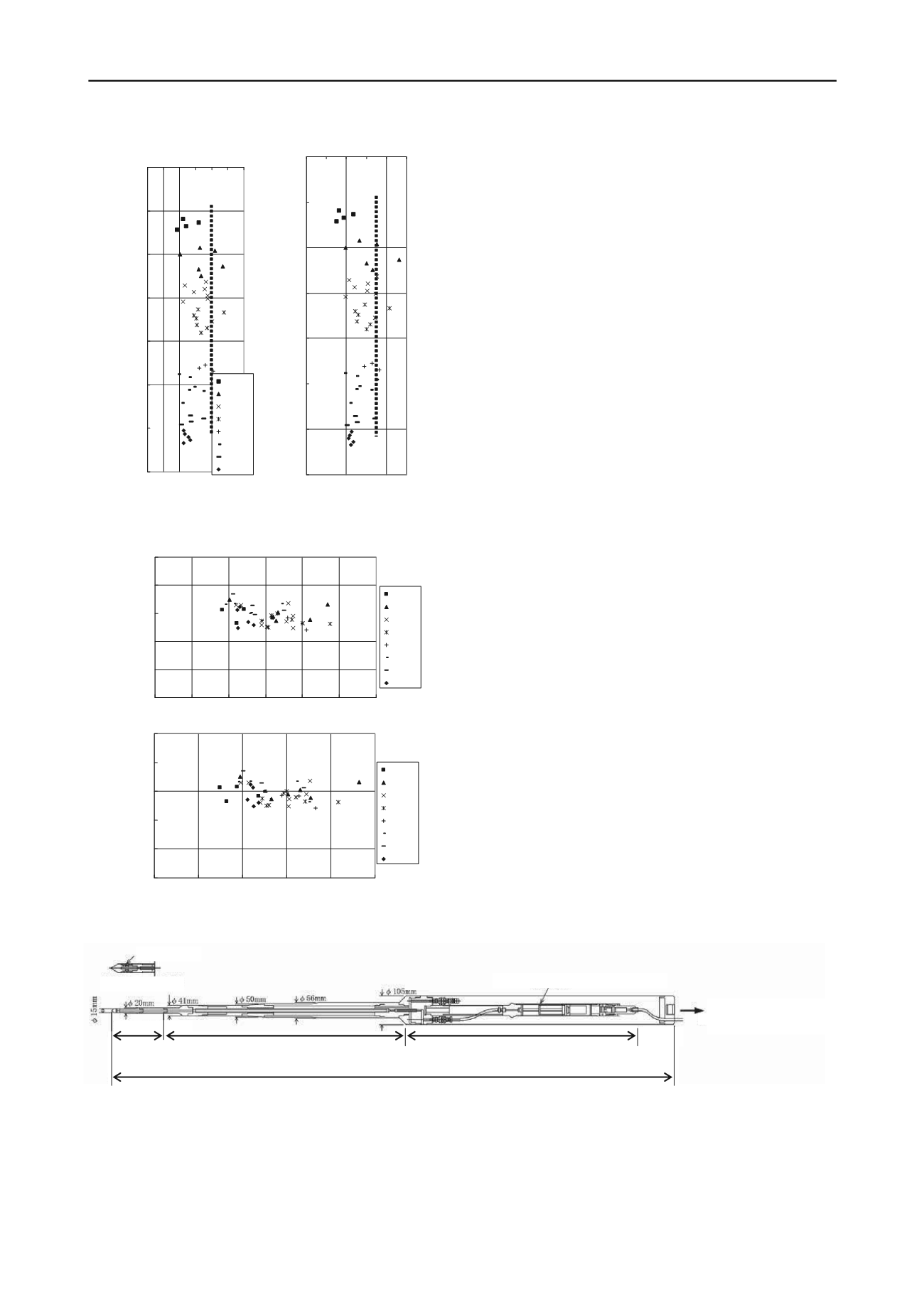
609
Technical Committee 102 /
Comité technique 102
- 350
- 300
- 250
- 200
- 150
- 100
- 50
0
0 1 2 3 4 5 6
ε
vo
(%)
深度 ( m)
Ma12
Ma11
Ma10
Ma9
Ma8
Ma7
Ma4
Ma3
ε
vo
=4%
- 350
- 300
- 250
- 200
- 150
- 100
- 50
0
0.00 0.02 0.04 0.06 0.08 0.10
Δ
e
/
e
o
深度( m)
Δ
e
/
e
0
=0.07
Dept h ( )
Dept h ( m)
Figure 3. Result of
ε
v0
and Δ
e
/
e
0
obtained by CRS test.
0.0
0.5
1.0
1.5
2.0
2.5
0.00 0.02 0.04 0.06 0.08 0.10
Δ
e
/
e
o
過圧密比(
OCR
)
Ma12
Ma11
Ma10
Ma9
Ma8
Ma7
Ma4
Ma3
0.0
0.5
1.0
1.5
2.0
2.5
0.0 1.0 2.0 3.0 4.0 5.0 6.0
ε
vo
(%)
過圧密比(
OCR
)
Ma12
Ma11
Ma10
Ma9
Ma8
Ma7
Ma4
Ma3
Overconsol i dat i on rat i o (
OCR
)
Overconsol i dat i on rat i o (
OCR
)
Figure 4. Relationship between OCR and
ε
v0
, Δ
e
/
e
0
.
4 MEASURMENT OF PORE WATER PRESSURE IN
GREAT DEPTH
4.1 Cone type measuring equipment of pore water pressure for
Pleistocene clay (GD-CONE)
The measurement of pore water pressure for clay layer is used a
push-in type piezometer (JGS 1313-2003) .This type of
piezometer has a merit which can seal the measuring section
completely and can measure a correct pore water pressure.
Therefore, this is usually used in shallow depth and cannot use
such great depth which is up to 350m in depth because of the
capacity of sensor and the penetrating power of cone.
The cone type measuring equipment of pore water pressure
for Pleistocene clay in great depth called GD-CONE has been
developed. The structure of this equipment is shown in Figure 5.
The characteristics of this cone are as follows:
The tip part which is the penetrating part is very thin in order to
decrease the penetrating resistance and promote the dissipation
of pore water pressure. Its diameter is only 15mm to 20mm.
The upper part of the tip becomes thicker gradually. Its diameter
is 41mm to 56mm. This part is penetrated into the small
borehole, which is drilled in advance, to seal the testing section
completely.
GD-CONE is connected with AQ rod whose outer diameter is
44.5mm and installed into the borehole. During installation of
GD-CONE, the center riser fixed to AQ rod is used in order to
install into the pre-drilled small borehole correctly.
The pressure gauge of GD-CONE has used a crystal oscillation sensor
which has wide pressure range and high sensibility. The maximum
pressure range is 5MPa and the sensibility has 0.01%FS. The
compensation of atmospheric pressure has been done by using another
pressure gauge on the ground.
4.2 New type measuring equipment of pore water pressure for
sand (H-MHT)
The measurement of pore water pressure for sand layer in great
depth is used a new type measuring equipment of pore water
pressure called H-MHT. The structure and test procedure of H-
MHT is shown in Figure 6. The characteristic of H-MHT are as
follows:
As the principle of measurement is simple, the reliable
measurement is possible easily.
As the pressure gauge of H-MHT has used a crystal oscillation
sensor too, the high pressure caused in the great depth can
be measured highly precise.
H-MHT can obtain equilibrium water table in a short time because the
specific air valve which is joined to the AQ rod can shut the test
section in order to promote dissipation of pore water pressure
rapidly.
Metal filter
Tip part
Crystal oscillation sensor
Connection to AQ rod
(Outer diameter: 44.5mm,
Inner diameter: 34.9mm)
Length 2,540mm
(300mm)
Penetrating part
Sealing part
Pore water pressure measuring part
Figure 5. Structure of cone type measuring equipment of pore water pressure for Pleistocene clay (GD-CONE).


